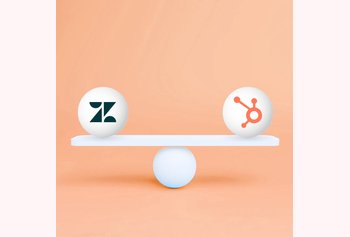Top 30+ Customer Service Survey Questions Examples

Table of contents
When you deliver great customer service, there’s a chance it could fly under the radar. But when it’s bad, everyone remembers. Customers leave negative reviews, tell their friends and families about it, and even resort to social media to share their experience with everyone.
That’s why proactively taking customer feedback from time to time becomes important. In fact, this Hiver report shows that 72% of customers switch brands after just one negative experience.
So, what’s the best way to figure out what your customers love or hate?
It all starts with asking the right questions. You need to ask questions that dig deeper into their expectations and experience. Questions that reveal what drives loyalty and, on the flip side, frustration.
To make things simpler, we’ve curated the top customer service survey questions that you should ask to get the best picture of your service operations. Let’s dive in.
Table of Contents
- Why Use Customer Service Surveys?
- Top 30+ Customer Service Survey Questions to Ask Your Customers
- Best Practices for Creating Effective Customer Surveys
- Improve Your Customer Service By Asking The Right Questions
- Frequently Asked Questions (FAQs)
Why Use Customer Service Surveys?
Customer service surveys help you understand what’s happening in your business from your customer’s perspective. These surveys give you straight-cut answers to your customer’s expectations and how well your business is fulfilling them.
Here’s why surveying your customers is worth the effort:
- Pinpoints customer pain points: Surveys give customers a voice to tell you exactly what’s bothering them. For instance, maybe your support team is doing great, but the follow-up process is lacking. You’d never know unless you ask!
- Drives continuous improvement: You can use these survey data to improve your business operations. For instance, when customers give you negative feedback, they’re essentially hinting at what needs fixing. It’s not just about fixing what’s broken today but also about setting up processes that keep things smooth in the future.
- Boosts customer loyalty: When you act on survey feedback, customers notice. Plus, it shows that you actually care about what they have to say. For instance, a simple improvement, like reducing wait time on calls, can be the difference between a one-time buyer and a loyal customer who sticks around.
- Gets you ahead of the competition: Regularly gathering customer insights allows you to stay one step ahead, addressing concerns before they turn into bigger issues. Surveys can reveal trends in customer behavior that you might not have noticed otherwise. This helps you make smarter decisions and keep your edge.
Top 30+ Customer Service Survey Questions to Ask Your Customers
When you conduct customer service surveys, you need to tailor the questions to dig deep into the specific areas of their experience.
In this section, we’ll break down different types of customer service surveys and provide examples of the important questions that get to the heart of what matters most.
Customer satisfaction surveys
Customer satisfaction surveys, commonly known as the CSAT surveys, are all about gauging how happy (or unhappy) your customers are with your service. These are quick, targeted questions that will tell you if you’re hitting the mark—or if there’s room for improvement.
Some important questions that you can include in your surveys are:
1. On a scale of 1-5, how satisfied were you with your interaction with our support rep today?
2. Did our team resolve your issue to your satisfaction? (Yes/No question)
3. How would you rate the quality of service you received? (Excellent/Good/Fair/Poor)
4. What can we do to improve your experience?
5. Would you use our service again in the future? (Yes/No)
Customer effort surveys
Customer Effort Score (CES) surveys focus on how easy or difficult it was for your customers to resolve their issues. Customers who find it difficult to get what they need are less likely to stick around, so it’s crucial to measure their effort.
6. On a scale of 1-10, how easy was it to resolve your issue today?
7. Did you have to contact us more than once to resolve your problem? (Yes/No)
8. How long did it take to get your issue resolved? (Less than 1 hour/1-3 hours/More than 3 hours)
9. Was there anything that made the process of resolving your query difficult for you?
10. What could we have done to make your experience easier?
Net Promoter Score (NPS) surveys
NPS surveys are the go-to for measuring customer loyalty. They’re simple but powerful, focusing on whether your customers would recommend your product or service to others. This is a strong indicator of their long-term loyalty.
11. On a scale of 0-10, 0 being not at all likely and 10 being most likely, how likely are you to recommend our service to a friend or colleague?
12. What is the primary reason for the score you gave?
13. What could we do to improve your score in the future?
14. Have you recommended us to anyone in the past? (Yes/No)
15. How likely are you to continue using our service over the next year? (Scale of 1-10)
You may also like: Top 11 Customer Engagement Metrics To Measure
Support agent-specific surveys
These surveys focus on the performance of the individual customer service agents your customers interact with. You want to know if your team is not only knowledgeable but also proactive, approachable and empathetic.
Here are some of the important questions you can ask:
16. On a scale of 1-5, how would you rate the knowledge of the agent who assisted you?
17. Did the agent understand your issue clearly? (Yes/No)
18. Was the agent courteous and respectful? (Yes/No)
19. How well did the agent explain the solution to your issue? (Very well/Somewhat well/Not well at all)
20. Did you feel the agent genuinely cared about resolving your issue? (Yes/No)
Channel-specific questions
As a business, you may have multiple communication channels – email, chat, phone, or more – through which your customers reach out to you.
These survey questions help you determine which channels are working best and where you might need to improve.
21. Which channel did you use to contact us today? (Chat/Email/Phone/Social Media)
22. On a scale of 1-5, how satisfied were you with the support received on [specific channel]?
23. Was this your first time using this channel? (Yes/No)
24. Would you use this channel again in the future? (Yes/No)
25. What could we do to improve your experience with this channel?
Product-specific feedback survey
If you are a product-based company, you also need to ensure that your products meet your customers’ needs and expectations. So, once your customers purchase a product, conduct a survey to identify areas where your product might be falling short.
Here are a couple of important questions:
26. On a scale of 1-5,, how satisfied are you with the product you purchased?
27. Did the product meet your expectations? (Yes/No)
28. What features of the product do you find most useful?
29. Is there anything you wish the product did differently?
30. How easy was it to use the product? (Very easy/Somewhat easy/Difficult)
You may also like: 10 Engaging Product Update Email Templates
Feedback on self-service tools
If you offer self-service options like a knowledge base, guides, chatbots, and more, you need to understand how easy to use and helpful these options are.
This will help you refine the customer experience, in case they do not find these tools user-friendly. Here are a couple of questions that can help you find this out:
31. Did you try using our self-service options before contacting support?
32. Were you able to find the information you needed in our [self-service tool]?
33. On a scale of 1-5, 1 being very hard and 5 being very easy, how would you rate the ease of use of our self-service tools?
34. What could we improve in our self-service resources?
Open-ended surveys
Sometimes, close-ended questions like rating scales and yes/no type questions do not provide enough insights into your customers’ experience. In such cases, you need open questions that can help them express themselves freely, which provides valuable qualitative insights.
Here are a couple of such open-ended questions. Feel free to mix them with other closed-ended questions to get as many insights as possible.
35. In your own words, how would you describe your experience with our customer service today?
36. What could we have done better during your interaction with our support team?
37. Is there anything else you’d like us to know about your experience?
38. What’s the one thing we could do to improve our service?
These questions will give you a complete picture of your customer service operations’ efficiency and areas for improvement.
Make sure to pick and choose the survey questions according to your business needs and the areas you want to measure.
Best Practices for Creating Effective Customer Surveys
Creating a customer service survey is simple. But what matters is doing it in the right way- and that requires some thought. The goal is to collect meaningful insights to drive real change in your business.
So, how do you make sure your surveys are hitting the mark? Here are some best practices to ensure you’re getting the feedback that matters.
1. Keep it short and focused
Nobody enjoys filling out lengthy surveys. The trick is to ask only what’s necessary. Stick to the essentials and be mindful of your customers’ time. As a general rule, your survey shouldn’t take more than 5-10 minutes to complete.
Pro tip: If you have a lot of questions, divide the survey into smaller sections or use a progress bar so respondents know how much time they have left. This helps reduce fatigue and increases the likelihood of getting completed responses.
2. Ask clear and simple questions
Your survey questions need to be simple and crystal clear. Avoid jargon or complicated language. If a question isn’t straightforward, you may get unreliable answers that won’t be insightful.
Pro tip: Before sending out the survey, test it with a small group to ensure that all questions are easily understood. If anyone has to ask, “What does this mean?” It’s time to rephrase.
3. Use a mix of different types of questions
Don’t stick to just one question type. Mix things up with multiple-choice questions, rating scales, and open-ended questions to gather more comprehensive insights. Multiple-choice questions provide quick answers, while open-ended questions allow customers to share more detailed thoughts.
Pro tip: Start with simple rating questions, and then follow up with open-ended ones to get more context. For example, you can ask, “On a scale of 1-5, 1 being very dissatisfied and 5 being very satisfied, how satisfied were you with our service?” followed by “What could we do to improve?”
4. Timing is everything
The best time to send out a survey is right after a customer interaction—while the experience is still fresh. Whether it’s after a support call, a purchase, or the resolution of an issue, send your survey at the right moment to get accurate feedback.
Pro tip: Automate your surveys to go out within 24 hours of a customer interaction, like after a purchase or customer support call. This will take care of the manual grunt work.
Recommended read: Create rule-based automation with Hiver
5. Avoid leading questions
Leading questions can lead to biased responses and skewed data. So, if you’re looking for honest feedback, make sure your questions are neutral. For example, instead of asking, “How amazing was our service today?” go for something more neutral, like, “How would you rate your service today?”
Pro tip: After drafting your survey, review your questions to ensure they have a neutral tone and do not push the customer toward a specific answer.
6. Make the surveys mobile-friendly
People check emails and browse online mostly on the go, so it is crucial to ensure your survey works well on mobile devices. A clunky, hard-to-navigate survey will lead to fewer completions.
Pro tip: Test your survey on different devices and screen sizes to make sure it’s easy to fill out on any platform.
7. Offer an incentive
Offering a small incentive, like a discount or a chance to win a prize, can significantly increase your survey response rate. People are more likely to take time out of their day if they feel there’s something in it for them.
Pro tip: Be upfront about the incentive in your survey email or introduction. But make sure it’s relevant to your audience to avoid attracting disengaged respondents.
8. Close the feedback loop
Many brands often miss this important step. After you’ve gathered responses, don’t just leave your customers hanging. Let them know you’ve listened to their feedback and, more importantly, tell them what actions you’re taking as a result. This helps build trust and shows that their opinions truly matter.
Pro tip: Send a follow-up email highlighting the changes or improvements you’re making based on the survey results. This simple step can go a long way in building customer loyalty.
Improve Your Customer Service By Asking The Right Questions
Customer service surveys are the best way to truly understand your customers’ needs and how your service can improve to fulfill them. Ask the right questions and follow the best practices to get the most out of your surveys.
Also, remember, the timing of your sending out your surveys is important. You’ll get the most accurate insights by surveying your customers right after an interaction. That’s why it’s best to automate the process so that you never miss out on collecting feedback.
If you are looking to automate your surveys, tools like Hiver can help. It is a help desk through which you can automate sending out CSAT surveys right after every customer interaction.
Plus, with Hiver, your team can handle customer queries right from their inbox, making it easier to provide support without switching platforms. Whether you’re tracking performance metrics, prioritizing customer inquiries, or improving team collaboration, Hiver equips you with everything you need to deliver outstanding service.
Start a free trial to explore features.
Frequently Asked Questions (FAQs)
- How often should I send customer service surveys?
It’s a good practice to send surveys immediately right after an interaction, such as after a customer service call or purchase. This ensures the feedback is fresh and accurate.
- How do I handle negative feedback from customer surveys?
Consider negative feedback as an opportunity for improvement. Respond promptly, thank the customer for their honesty, and outline steps you’ll take to address their concerns.
- Can I customize my customer service survey to fit different customer segments?
Yes! To get more tailored insights, it’s recommended that you customize your survey for different customer segments. For example, you can segment into new customers and long-term customers.
- What’s the difference between CSAT, NPS, and CES?
- CSAT (Customer Satisfaction Score) measures how happy customers are with your service or product.
- NPS (Net Promoter Score) gauges customer loyalty by asking how likely customers are to recommend your service to friends and family.
- CES (Customer Effort Score) focuses on how easy it was for customers to resolve their issues, highlighting the effort required.

































